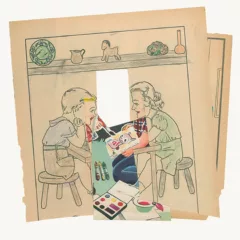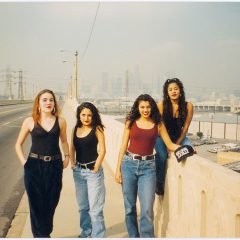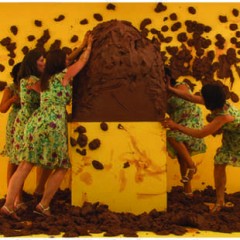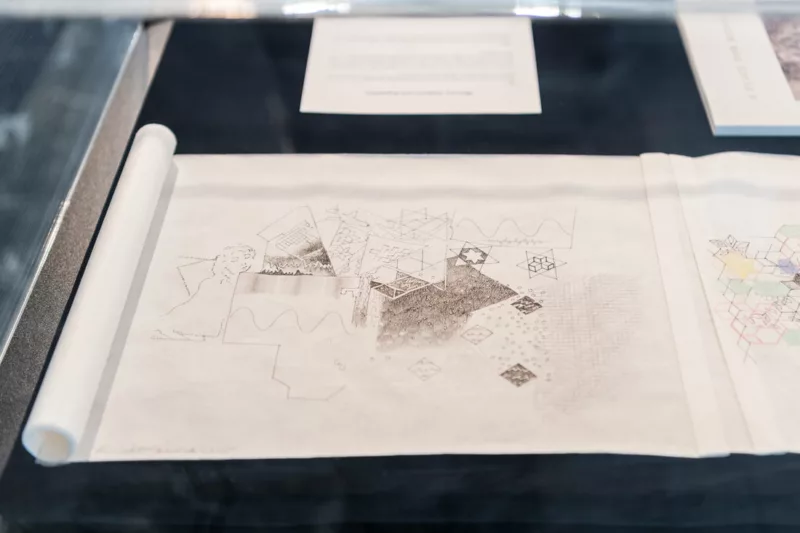
When I first met Patricia Moss-Vreeland, I instantly knew we were kindred: as an anti-hyper-specialist, I found my cognitive match in her thought process, her approach to working in multiple media, and her insight into her newest exhibition. In Search of Meaning: Memory Becomes Us is currently open at the Phillips Museum of Art, Franklin & Marshall College, through December 8, 2023, and is the 4th iteration of a long-standing traveling show. Previous iterations took place at the Esther Klein Gallery, University City Science Center in 2019, the Maryland Hall for the Arts, Chaney and Martino Galleries in 2021, and the Sordoni Art Gallery, Wilkes University 2022. Moss-Vreeland continues to deepen her connection to memory, science, history and language through ongoing work, and looks to pursue future iterations of this exhibition with additional and diversifying pieces, emphasizing that what we remember is constantly in flux.
The exhibition at Phillips combines the particular memory of the artist, and the general memory we share in our human experience, with scientific insights born from collaboration with University of Oregon cognitive neuroscientist Dr. Dasa Zeithamova.
The gallery space features movable panels and gallery walls mounted with mixed-media pieces, many of which incorporate poetry. Each piece resembles collage in its amalgamation and superimposition of starkly contrasting abstract and representational imagery, and techniques of paint, drawing, photography, printmaking, and written text. Some images present serially in vertical diptychs, triptychs, and so on, where others display overlapping elements in singular compositions. The floor spaces among the walls host several free-standing sculptures in paper and other materials, including a multisensory piece on smell done in collaboration with the Monell Chemical Senses center. Finally, viewers are invited to pause for a 20-minute looped video that consists of three original poems adapted with visuals, voiceover recitation, and sound art, intermittently cut with six interviews on memory with prominent subjects including Lorene Cary, Blanka Zizka, and Carlotta Mismetti Capua.
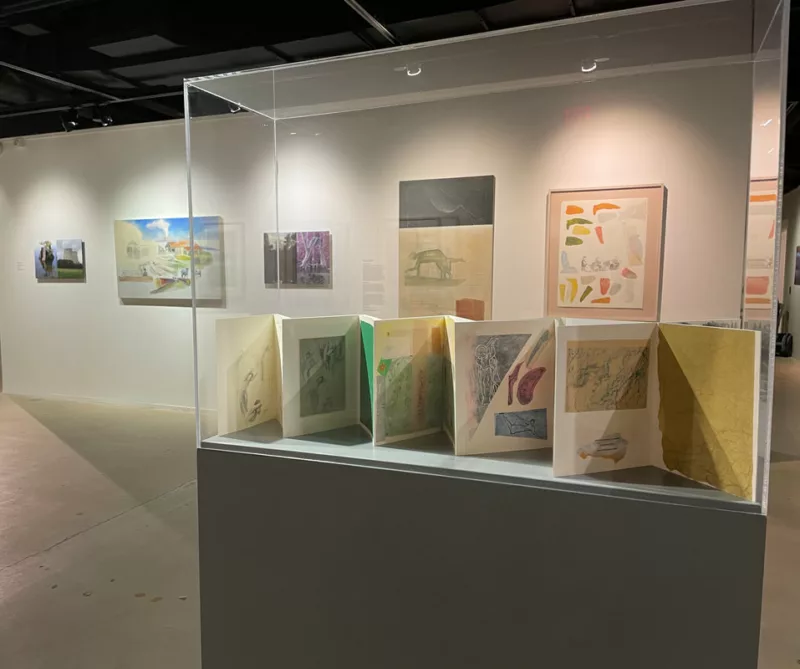
Ultimately, the works of In Search of Meaning: Memory Becomes Us are equally filled with written and visual metaphor, allowing for viewers to read, hear, smell, and connect with pieces freely based on their own personal relationships with and interpretations on memory. Moss-Vreeland, in her write-up for the show, states: “Memory is a universal human process but is also deeply subjective and personal. This is exciting for me because it means that when we examine memory, there’s the potential to understand our own individual experience more fully, to see who we are–and at the same time to find points of connections with others.” Given Moss-Vreeland’s enthusiasm surrounding this decades-long body of work, I felt it best to honor her artistic integrity with an interview, in addition to comments on her Phillips Museum installation.
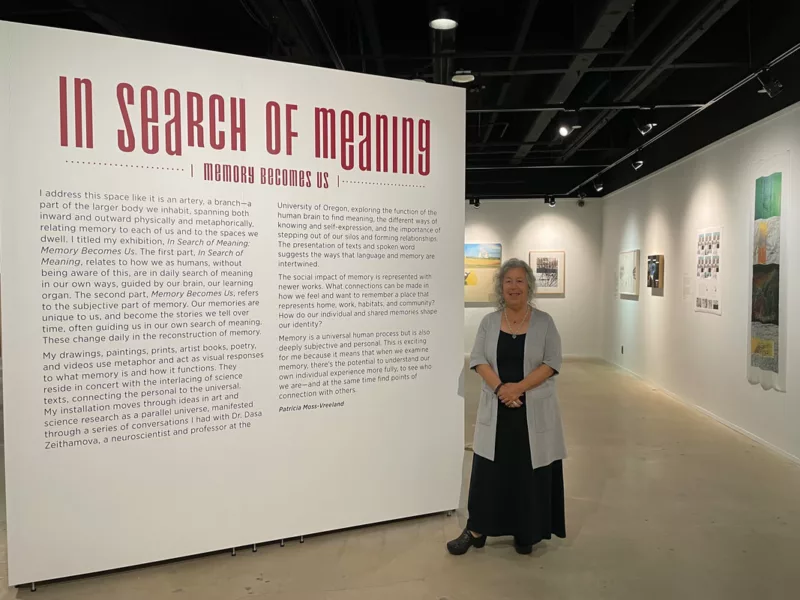
I have transcribed, edited and paraphrased the following for flow and clarity.
Martina Merlo: You are a very prolific artist in multiple media; what prompted your interest in embedding poetry into your work, and how did that inform In Search of Meaning: Memory Becomes Us?
Patricia Moss-Vreeland: I was always writing a lot, but it was private; I enjoyed having something where I was expressing myself differently and nobody knew about it. After winning an important competition for a permanent installation, I realized that art can have so much more meaning beyond what I was initially doing! And what better topic to approach than the art and science of memory? I began working in 1999 with a fantastic neuropsychologist at Jefferson, Dr. Barbara Malamut, who would show me MRIs and tell me about the brain and memory. I initially showed her something I wrote, and she said: ‘You turned my words of science into a poem’. That poem became the gateway to my exhibition, Memory – Connections Matter, nicknamed ‘A Metaphoric Walk through the Brain’. Because I was camouflaging my poetry in my visuals, it felt more comfortable. I didn’t study poetry, so initially I framed it as painting or drawing with words, until I got to the point you see today where I’ve published an entire book of them, removed from their visuals. With my poetry and visual art, one informs the other.
Martina: Please tell me how your rendering and compositional styles in 2-D and 3-D pieces work with the conceptual background of memory.
Patricia: When I was learning more about the science of the brain it afforded me a different ability to understand how faceted memory is. My works, specifically my “bands” paintings, show the way our brains freely associate, where our neuronal structures connect different fragments throughout the brain. I always gravitated toward banded composition and assemblage, so the concept of association helped liberate later works from adhering to realistic rendering.
Martina: You mentioned to me that you add new works to each exhibition: which are you most excited about for this iteration?
Patricia: Every time I learn something new, I look for opportunities to share it. There’s so much new information in this exhibition; for instance, I wanted people to be able to read the conversations between myself and Dr. Zeithamova, where the scientist reacts to the art. There’s a lot of work that’s educational, including other collaborative scientific pieces, one of which involves smell: the strongest connection to memory.
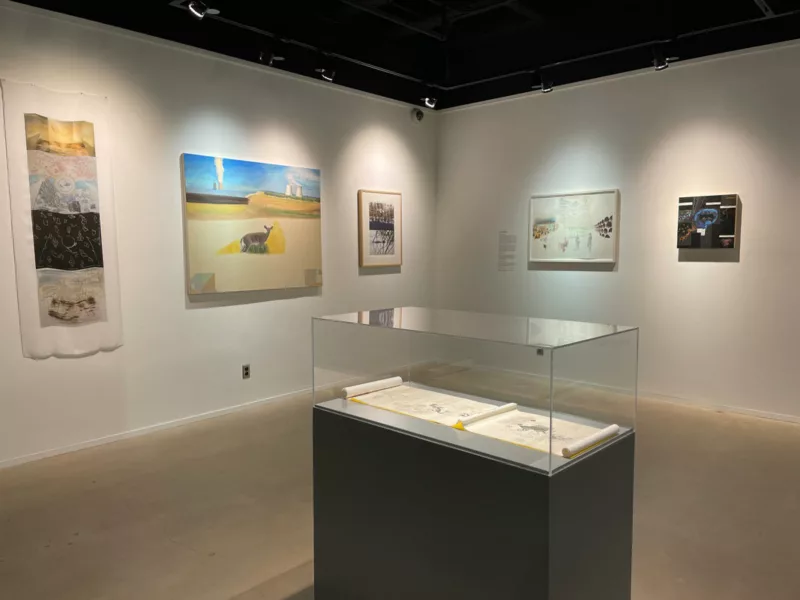
Comments on the exhibition
Where Patricia Moss-Vreeland excels in traditional fine art media and realism, her acumen lies in the diversity and freedom with which she combines these conventional skills with alternative materials and representational methods. Her approach to creating a body of work is additive: no single experience in Moss-Vreeland’s artistic journey is irrelevant, because it all derives from and belongs to her memory. Despite the sheer volume and variety of works within the exhibition, it does not overwhelm. Instead, many pieces share repeated elements that allow us to seek connections among them, and understand the works as a singular mind; namely, Moss-Vreeland’s collection of memories. Where Patricia Moss-Vreeland invites viewers to discover their own meanings from her pieces, I too pondered my relationship with memory through her work.
Particularly salient to me are the mixed-material pieces incorporating poetry, bridging her fine art with book arts. Her wall-mounted pieces such as “Rhapsody” and “The Economy of Being a Woman” are assemblages, where the combination of drawing, printmaking, and even hand-designed wallpaper, turn her writing into concrete poetry. Traditionally meant for recitation, poetry fossilized in visual art freezes time: these pieces are history immortalized, and fragments of memory preserved. Each work refutes chronology, as viewers are invited to freely associate with past, present and even future experiences.
My favorite sculptural form is “Re-Emerging Patterns.” A continuous ink drawing on a rice paper scroll, this piece incorporates serial drawings of geometric patterns, grids, and concentric shapes. Reading left-to-right, the drawing begins with a loosely-outlined figure and lines that form large shapes, quickly accumulating in density to become a series of six-point stars in multiple scales and other tight linear patterns that eventually become large shaded swatches. The drawing simultaneously incorporates, superimposes, and refutes grids of all types. The scroll continues into the second panel with further lines–some solid and some dashed–to create a new pattern that becomes repeated in larger scales, smaller scales, with just outlines, and also with shading. This panel incorporates accent colors for an instant, quickly abandoning them for the purity of black ink. Superimposed with the geometric are more curvaceous forms, where soft and frenetic marks show movement, revolving around a central circular shape. The scroll continues to evolve in a more representational direction from whence it began, showing a silhouette of a figure floating above a spiraled plane. Ultimately, the poetry of the piece lies in the contemplative process and constantly-evolving patterns:
“Patterns are so important to the construction of memory. This is something I wanted to start without knowing the ending, because that’s how memory works.”
In Search of Meaning, Memory Becomes Us, Poems from an Exhibition is the title of Moss-Vreeland’s first published poetry book, which includes 20 of the poems embedded in her exhibition along with others from her personal archive. The book is a separate work of art in itself, and also functions as yet another branch.of Patricia Moss-Vreeland’s continual explorations and expressions on memory. Where the Phillips Museum of Art’s In Search of Meaning: Memory Becomes Us runs through December 8th, 2023, readers can continue to connect with and remember the show long after.
In Search of Meaning: Memory Becomes Us, at The Phillips Museum, Franklin and Marshall College, through Dec. 8, 2023.
See the exhibit online
See a talk Patricia Moss-Vreeland gave at Franklin and Marshall College in conjunction with her exhibit in the Phillips Museum.


